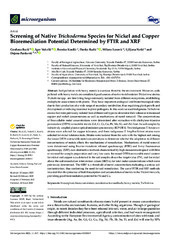Приказ основних података о документу
Screening of Native Trichoderma Species for Nickel and Copper Bioremediation Potential Determined by FTIR and XRF
| dc.creator | Racić, Gordana | |
| dc.creator | Vukelić, Igor | |
| dc.creator | Kordić, Branko | |
| dc.creator | Radić, Danka | |
| dc.creator | Lazović, Milana | |
| dc.creator | Nešić, Ljiljana | |
| dc.creator | Panković, Dejana | |
| dc.date.accessioned | 2023-06-01T10:47:19Z | |
| dc.date.available | 2023-06-01T10:47:19Z | |
| dc.date.issued | 2023 | |
| dc.identifier.issn | 2076-2607 | |
| dc.identifier.uri | https://riofh.iofh.bg.ac.rs/handle/123456789/988 | |
| dc.description.abstract | Soil pollution with heavy metals is a serious threat to the environment. However, soils polluted with heavy metals are considered good sources of native metal-resistant Trichoderma strains. Trichoderma spp. are free-living fungi commonly isolated from different ecosystems, establishing endophytic associations with plants. They have important ecological and biotechnological roles due to their production of a wide range of secondary metabolites, thus regulating plant growth and development or inducing resistance to plant pathogens. In this work we used indigenous Trichoderma strains that were previously isolated from different soil types to determine their tolerance to increased copper and nickel concentrations as well as mechanisms of metal removal. The concentrations of bioavailable metal concentrations were determined after extraction with diethylene-triamine pentaacetate (DTPA)-extractable metals (Cd, Cr, Co, Cu, Pb, Mn, Ni, and Zn) from the soil samples by inductively coupled plasma-optical emission spectrometry (ICP-OES). Two indigenous T. harzianum strains were selected for copper tolerance, and three indigenous T. longibrachiatum strains were selected for nickel tolerance tests. Strains were isolated from the soils with the highest and among the lowest DTPA-extractable metal concentrations to determine whether the adaptation to different concentrations of metals affects the mechanisms of remediation. Mechanisms of metal removal were determined using Fourier-transform infrared spectroscopy (FTIR) and X-ray fluorescence spectroscopy (XRF), non-destructive methods characterized by high measurement speed with little or no need for sample preparation and very low costs. Increased DTPA-extractable metal content for nickel and copper was detected in the soil samples above the target value (TV), and for nickel above the soil remediation intervention values (SRIVs), for total metal concentrations which were previously determined. The SRIV is a threshold of metal concentrations indicating a serious soil contamination, thus confirming the need for soil remediation. The use of FTIR and XRF methods revealed that the presence of both biosorption and accumulation of metals in the Trichoderma cells, providing good bioremediation potential for Ni and Cu. | en |
| dc.publisher | MDPI AG | |
| dc.relation | European Union [101079267] | |
| dc.relation | Provincial Secretary for Higher Education and Scientific Research, Autonomus Province of Vojvodina project [142-451-3172/2022-01/01] | |
| dc.rights | openAccess | |
| dc.rights.uri | https://creativecommons.org/licenses/by/4.0/ | |
| dc.source | Microorganisms | |
| dc.subject | Trichoderma | en |
| dc.subject | nondestructive methods | en |
| dc.subject | heavy metals | en |
| dc.subject | biosorption | en |
| dc.subject | bioaccumulation | en |
| dc.title | Screening of Native Trichoderma Species for Nickel and Copper Bioremediation Potential Determined by FTIR and XRF | en |
| dc.type | article | |
| dc.rights.license | BY | |
| dc.citation.issue | 3 | |
| dc.citation.other | 11(3): - | |
| dc.citation.rank | M22~ | |
| dc.citation.volume | 11 | |
| dc.identifier.doi | 10.3390/microorganisms11030815 | |
| dc.identifier.fulltext | http://riofh.iofh.bg.ac.rs/bitstream/id/495/985.pdf | |
| dc.identifier.pmid | 36985388 | |
| dc.identifier.rcub | conv_1096 | |
| dc.identifier.scopus | 2-s2.0-85151418059 | |
| dc.identifier.wos | 000960176100001 | |
| dc.type.version | publishedVersion |

